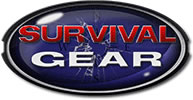The Basic Survival Pantry
Many people imagine that a survival stockpile of food would have to consist of either boxes of MREs stacked to the ceiling, or high shelves full of specially prepared #10 cans in a bomb shelter. While these can certainly be viable food storage options for some, putting aside a survival stockpile of food doesn't necessarily have to be so daunting or specialized.
Basic Survival Pantry
There are a number of inexpensive food options available from normal grocery stores and mass market retailers which can serve as a basic starting point for a hard times food storage plan. These items can either be used to flesh out meals during a time of partial shortage, or even used to subsist on entirely in more dire circumstances.
Note that many food items one buys will require both a means of cooking and a source of water. One can either store water or arrange for purification methods to be available. Doing both is a wise course. Cooking can be accomplished in a number of ways ranging from simple appliances like a Kelley kettle, to advanced camp stoves or even installing a wood burning stove into the home. However, due to the suffocation danger, one should never bring the home BBQ indoors!
Boxed meals such as macaroni and cheese can be surprisingly useful. The instructions will call for milk, but one can either use powdered milk instead or simply omit it altogether and still end up with an edible - albeit less cheesy - product. Bulk macaroni was actually a staple of international relief supplies during the siege of Sarajevo during the Balkan wars of the early 1990s. Spaghetti can serve a similar role.
Staples of college dorm life can also be pressed into service in the form of Minute Rice (or other brands of "instant" rice) and various brands of Ramen noodles. In a pinch, one can simply soak these in water and obtain an edible result if hot water isn't available.
Bags of corn meal are also very versatile. By simply adding a bit of water, one can fry up or bake crude Johnny cakes similar to those that soldiers would subsist on during the Civil War in the field.
A byproduct of the space age, in the form of Tang powdered drink mix, will meanwhile provide a modern and somewhat tasty way of avoiding the dangers of scurvy.
The shelves of any store should also contain a range of canned goods, many of which can be eaten without adding water or even heating. Canned beef stew, pork and beans, chili, and canned meats such as Spam are particularly good in this regard. Items to avoid are canned soups that require water as these will be too salty and don't really deliver enough calories. They are also rather unpalatable if one can't add water. Canned fruits can meanwhile add a bit of variety and serve as dessert. Canned vegetables are more of a mixed bag. One can often get by without them if they have access to multivitamins.
Other useful foodstuffs to have on hand include powdered milk and potato powder. The latter can actually be eaten cold simply by adding water and mixing it up into a slurry. It isn't the best tasting product when so prepared, but can be filling. If properly prepared, it can actually be quite tasty. The powdered milk can serve as a replacement for actual milk.
Tea bags are also available cheaply, and a hot beverage can be very soothing on a cold day. Tea seems less prone to aggravate thirst than coffee and can be brewed up either weak or strong depending on how much caffeine one wishes. In the United Kingdom, brewing up a bit of tea to improve morale has long been a part of survival training, and with good reason. It can warm the body and improve one's spirits. During hotter times, tea can be cooled for a refreshing beverage or used to disguise the taste of water purified with bleach.
-Christopher Fisher
Comments
Customer reviews
No posts found
